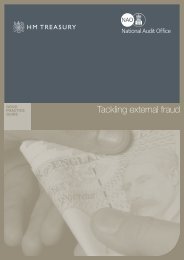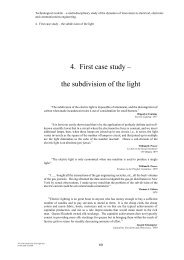a summary of the findings of the penrose inquiry into ... - HM Treasury
a summary of the findings of the penrose inquiry into ... - HM Treasury
a summary of the findings of the penrose inquiry into ... - HM Treasury
You also want an ePaper? Increase the reach of your titles
YUMPU automatically turns print PDFs into web optimized ePapers that Google loves.
committees. It should also set out <strong>the</strong> number <strong>of</strong> meetings <strong>of</strong> <strong>the</strong> board and<br />
those committees and individual attendance by directors.<br />
The role <strong>of</strong> <strong>the</strong> senior independent director is discussed below in <strong>the</strong><br />
guidance to Section A.3.3.<br />
A.1.3 The chairman should hold meetings with <strong>the</strong> non-executive directors without<br />
<strong>the</strong> executives present. Led by <strong>the</strong> senior independent director, <strong>the</strong> nonexecutive<br />
directors should meet without <strong>the</strong> chairman present at least annually<br />
to appraise <strong>the</strong> chairman's performance (as described in A.6.1) and on such<br />
o<strong>the</strong>r occasions as are deemed appropriate.<br />
The role <strong>of</strong> <strong>the</strong> senior independent director is discussed below in <strong>the</strong><br />
guidance to Section A.3.3.<br />
A.1.4 Where directors have concerns which cannot be resolved about <strong>the</strong> running <strong>of</strong><br />
<strong>the</strong> company or a proposed action, <strong>the</strong>y should ensure that <strong>the</strong>ir concerns are<br />
recorded in <strong>the</strong> board minutes. On resignation, a non-executive director<br />
should provide a written statement to <strong>the</strong> chairman, for circulation to <strong>the</strong><br />
board, if <strong>the</strong>y have any such concerns.<br />
A.1.5 The company should arrange appropriate insurance cover in respect <strong>of</strong> legal<br />
action against its directors.<br />
A.2 Chairman and chief executive<br />
Main Principle<br />
There should be a clear division <strong>of</strong> responsibilities at <strong>the</strong> head <strong>of</strong> <strong>the</strong><br />
company between <strong>the</strong> running <strong>of</strong> <strong>the</strong> board and <strong>the</strong> executive<br />
responsibility for <strong>the</strong> running <strong>of</strong> <strong>the</strong> company's business. No one<br />
individual should have unfettered powers <strong>of</strong> decision.<br />
Supporting Principle<br />
The chairman is responsible for leadership <strong>of</strong> <strong>the</strong> board, ensuring its<br />
effectiveness on all aspects <strong>of</strong> its role and setting its agenda. The chairman is<br />
also responsible for ensuring that <strong>the</strong> directors receive accurate, timely and<br />
clear information. The chairman should ensure effective communication with<br />
shareholders. The chairman should also facilitate <strong>the</strong> effective contribution <strong>of</strong><br />
non-executive directors in particular and ensure constructive relations between<br />
executive and non-executive directors.<br />
Code Provisions





![AIRTO [Professor Dr Brian Blunden] - HM Treasury](https://img.yumpu.com/15492848/1/184x260/airto-professor-dr-brian-blunden-hm-treasury.jpg?quality=85)










